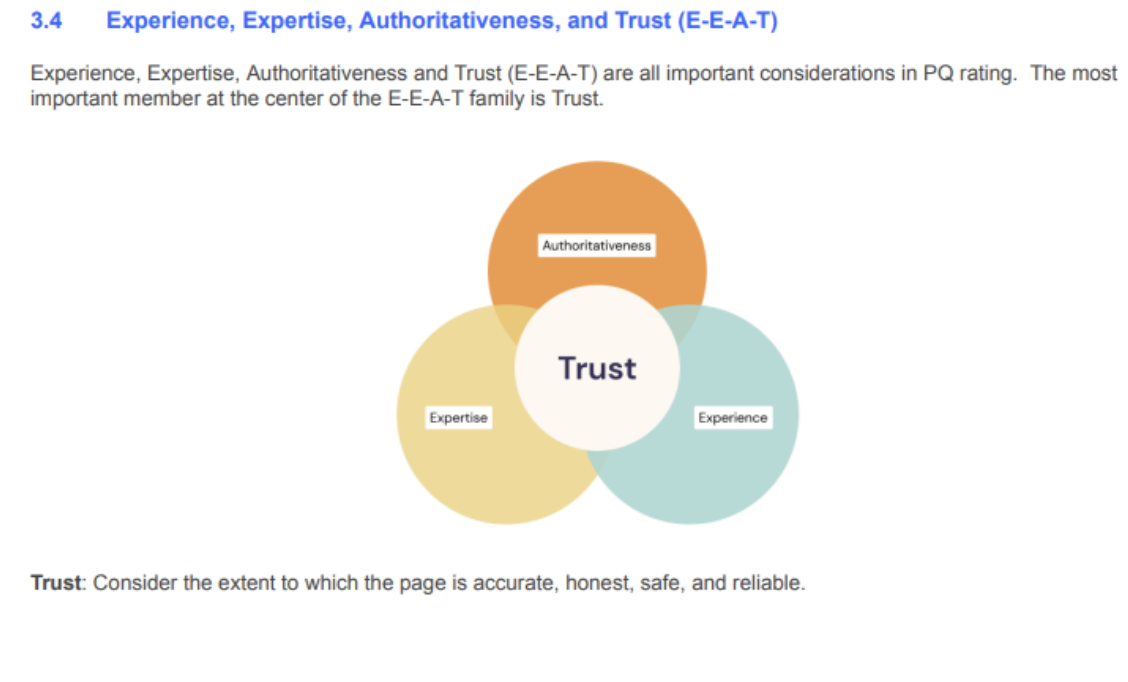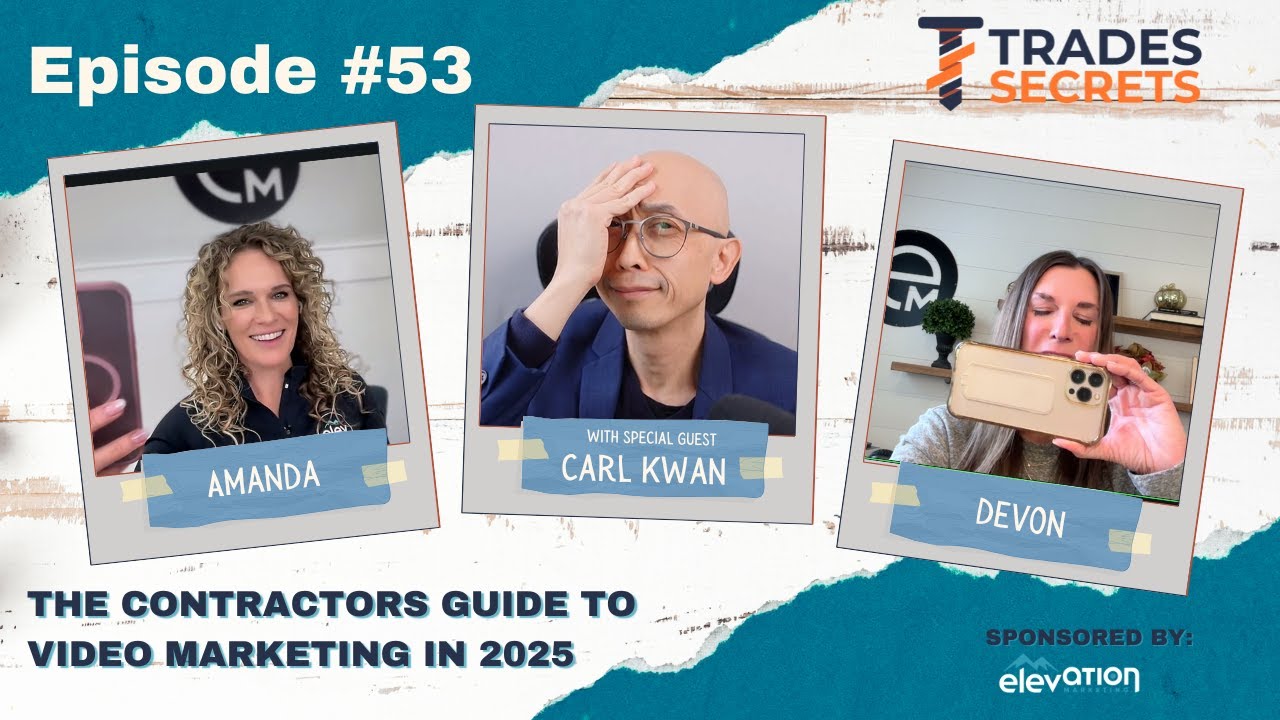What in the heck is AEO and why should you care? AEO stands for Answer Engine Optimization and is revolutionizing how we approach the search game. If you meet customers where they are with answers to their questions, you’re doing them a service—and building trust that converts leads.
As a trade professional, you should be optimizing answers to customer questions in order to dominate local search rankings.
AEO sounds fancy, but the way we see it, here’s your one chance, fancy, don’t let us down.
In this episode, you’ll learn to maximize local leads, leveraging AEO to position your business as the trusted authority in your market.
Here are a few things you’ll learn:
- What is AEO, and why is it critical for trades professionals?
- How to leverage long-tail keywords and voice search for local visibility
- How to create AEO-friendly content that answers customer questions effectively
- Practical strategies for embedding videos to boost engagement
- Plus so much more!
Ready for more? Subscribe today so you don’t miss a single trade secret reveal. Also be sure and connect with us on social: Instagram, Facebook, Twitter, LinkedIn & TikTok.
Send us your questions, comments, feedback, praise! We can’t wait to hear from you!
Transcript:
Devon Hayes:
Yeah. So yeah, this is an awesome episode. I think a great way to kick the year off talking about AEO and SEO and what that means. Just, I guess we should dive into what exactly AEO is, which is answer engine optimization, if you are not familiar. And then SEO, if you listen to this podcast, you know what that is, search engine optimization.
Amanda Joyce:
Yeah, so they’re cohesive friends, and we’re excited to just break this down for everybody a little bit. I know eight, 10 years ago, SEO was a buzz term that people were like, “What’s that mean?” And I think even my mom knows what SEO is now, maybe just from listening to us. But AEO is the new one, and you guys are probably going to be hearing your competitors talking about it. You’re going to be seeing information about it. And so today we just really want to break it down for you and help you understand how you can take advantage of it in your 2025 plan.
Devon Hayes:
Welcome to Trade Secrets, where we demystify digital marketing to help contractors get the most bang for their marketing bucks.
Speaker 3:
This is for you if you’re a contractor looking for actionable marketing insights. Learn from home services, industry experts to elevate your business through simplified marketing strategies.
Devon Hayes:
Let’s dive into today’s trade secret.
Amanda Joyce:
All right, so before we dive in and start nerding out on how to take advantage of AEO and all that stuff, let’s slow down and do a little bit more of an intentional job of explaining exactly what it is. So Devon, you are the expert on all these things. So rather than me trying to bumble through it, I’m going to pass it over to you.
Devon Hayes:
No, no, expert is pretty generous here. I think AEO, I mean, we talked about it last year at this time. We knew it was coming, but it’s answer engine optimization is getting your answer faster. So you have to think like voice search from Alexa. It is those AI summary overviews, it’s talking to ChatGPT, those. Anything that’s an answer engine, anything you turn to for an answer, not research, I would say falls under that AEO umbrella.
Amanda Joyce:
Yeah, I love that. I think that’s a really great concise way to explain it where you’re not doing research, you’re going out finding a quick, one simple answer to whatever it is you’re looking for. And as we’ve all experienced that in the wild, there’s so many different places we get that now. So it’s really critical to be thinking about that as you’re putting together your content strategy for the year ahead and identifying where you’re going to focus with your SEO because we’re all so used to that now. A year or two ago, that would’ve seemed so new and crazy and now we’re like, “I don’t know how I would live without it.” I mean, I don’t even want to say her name or she’ll start talking to me, but I ask my robots questions all day long.
Devon Hayes:
Well, and it’s nice when you don’t have time to sift through and know Google. God, loved their BERT update. It was all so they could match the user intent with your query. And sometimes they nail it and sometimes they don’t. But why you should care as a contractor or a trades business owner is that, A, it’s just the way of the future. But the buyer intent behind those AEO searches and what appearing in those searches can do for your business, is really impactful. You’ll see increased clicks through to your site, which is a trust signal for Google, which is part of, I think any business we’ve talked to. Organic leads are a critical component of their marketing strategy.
So combining those things and getting customers that care, customers that convert, more clicks through to the site, those instant answers and just meeting the customer where they are, are all the things that help make your business successful. So that’s why you should care.
Amanda Joyce:
Yeah, exactly. And it just establishes you as an authority on your given topic. So I mean, we all want that in whatever our area of focus is. We want to help people understand why we’re the one to trust. So this is the way to do it. And I think as we were kind of doing the research for this, one of the things that was really sticking out to me that I love is that so much of what we’ve been talking about on this podcast and that we talk to our clients about all the time, it’s just reinforces it. It’s really reinforcing what we know to be the best practices for SEO over the last couple of years. And now there’s this whole new way that Google’s really rewarding us with even more top of the SERPs visibility if we’re playing by their rules and creating really strong sticky content that answers questions, meets the clients where they’re at.
Now there’s just a lot prettier, fancier ways to serve up that content that we’re already working really hard to write.
Devon Hayes:
Absolutely. And I think… I don’t know, I think a lot of things. I’m not going to divert the topic, but it was so fun nerding out on this because we know we’ve kind of been monitoring it. In one of our SEO tools we can monitor who’s appearing for what in those AI overview summaries. And so our agency has been working on AEO along with any SEO clients, just something that you do because the nature of search has changed. And I mean, the future of search is changing. We were looking up some stats to give you guys the juiciest tidbits, and we learned that voice search increased 58% from 2023 in 2024. That’s crazy.
Amanda Joyce:
It’s crazy. Yeah. And then we were digging in more. We’re like, “How are we really dividing that out?” And it really is just those very long tail search terms that start with how, what, why? It’s people coming and asking for a very specific answer. And if you can meet them where they are, if they’re having… You name the issue in their home that you can solve for, if you can meet them right there and answer that question, provide that information they need to maybe rest a little easier and also know, “Oh my gosh, this person’s in my market and they can come help me.” You’re doing them such a huge service and at the end of the day, you’re really increasing the likelihood that they’re going to pick up the phone or they’re going to complete the lead form on your website.
Devon Hayes:
Yeah. And those micro marketing moments is what they’re called. It is just instantly being right there for them. Everything you just explained is that micro marketing moment and just meeting them right where they’re at. And then, touching back on why AEO is the future of search is even within Google itself, you can tell on that search engine results page, the SERPs page itself, how they’ve moved up. The people also ask section is closer to the top of the page than it’s been in the past. And then you have those featured snippets or enhanced featured snippets right at the top. Sometimes it’s just text, sometimes it’s images and multimedia that go along with the answer to your query.
You can tell what’s important to Google. Pay attention to what is where on the SERPs page, and that’ll tell you everything you should know about what you should be doing within your business by looking at the real estate on that results page on Google.
Amanda Joyce:
Yeah, I was going to say, I love that too, because I think a lot of us, we get so used to that kind of thing, you’re almost blind to it, but if you’re trying to be more aware of it, you’re going to start noticing how much you appreciate it when you’re out there searching for things in your daily life that have nothing to do with your business. And then when you start seeing those real world examples of it and realize how much easier it makes your life and how much it makes you suddenly trust that website or that service provider that popped up in your search results, it’s going to help you start to get creative with like, “Okay, what kind of questions do I want to answer for potential clients in my local market? How are we going to do that?” And that’s what we’re going to dive into a little bit more today.
But if you just have that kind of creative hat on when you’re thinking about things, it’s really important because then you can talk to your SEO company about what answers you want to make sure that your website’s covering, what information you’re sharing. Because at the end of the day, you are the expert in your field. You know what pushback you’re getting in the sales process. You know what burning questions someone has that you’re able to come over and solve for. So you just need to make sure you’re providing that in the content on your website and doing it concisely and the AEO results will follow.
Devon Hayes:
And you make a great point right here, you said, “Focus on SEO and those AEO results will follow.” That is, I think, critical for business owners to understand. You can’t go out and hire an agency and say, “I want you to do AEO. That’s the way of the future. That’s where I want to be. I hear it’s great for conversions and clicks through the site and branding, top of mind awareness. So do that.” It doesn’t work that way. So AEO and SEO have a direct correlation. You have to have a strong footprint in SEO because those answer engines are pulling from the top results. They’re pulling from the local three-pack. There is a direct correlation with your local three-pack visibility and you showing up, and the people also ask. There’s a synergy between those two things. So you can’t just walk in, purchase an AEO service and think that an agency is going to be able to get you results immediately.
What they’re going to do is provide SEO services and then structure the content for AEO. That’s a distinction I want to call out early because the next part of this podcast, we’re just talking about AEO, but you have to have an SEO foundation or else it’s highway robbery. They’re just going to take your money and run with it. You might be okay if you… Actually you won’t be okay, because if your website is structured in a way that where you have FAQs, you have multimedia, you’re already getting featured, your website’s already being favored for SEO.
Amanda Joyce:
Yeah. And if maybe by some heroics you manage to come up with one really long-tail FAQ that you answer on your website, and for a minute you’re featured in those snippets, another update or two, and Google gets a little bit smarter, and that one little piece of AEO that you got will be gone unless you’ve got the SEO foundation in place. Because they’re constantly getting smarter and figuring out ways to more efficiently index websites. And they’re only rewarding those of us that are getting in line and following the rules and structuring websites to meet those needs. And then when we do it, the visibility comes and it’s just so cool to even just think back on how boring search results like the SERPs were, three or four years ago. How freaking lame.
I’m so happy that it’s evolved the way it has. And I mean, God knows what it’s going to look like in a couple of years from now.
Devon Hayes:
I know. It is true just how much more rich the results are and how you can get those images and not just text up top. And I know, search is so cool. All right, so knowing that diving into now the juicy nuggets of this podcast and the benefits of AEO, now that you all know you have to have a foundation in SEO. You have to be ranking and doing well and have an organic footprint before you tackle AEO. Now that you all know that, let’s dive into some the benefits of AEO for your business.
Amanda Joyce:
So one of the juicy nuggets that we identified was just local visibility via voice search. So if you are truly optimized, like we talked about, you very well can show up for searches like, “Who’s the best plumber near me?” Having everything in place so that you’re ranking for something like that, that’s SEO gold and AEO gold. I mean, when I think about from a paid perspective, what you would pay to rank for a keyword like that, what you would pay for that click, you do not want to keep sinking your money into that year over year, month after month. But if you can put things in place so that you’re ranking for that, you’re doing it right.
Devon Hayes:
You’re doing it right. Yeah, attaboy, good job. So yeah, those hyper-local search queries, like the near me stuff, we saw a decrease in those for a while when we learned Google was not doing that exact phrase match anymore. They tracked your location for 13 months or whatever it was, and then was serving up answers that it deemed relevant to you. But voice search has brought back the rise of near me searches. But don’t worry, you can’t trick Google into thinking you’re somewhere you’re not. But all right, that’s it. That’s a great point. So local visibility via voice search, that’s point number one. All right, number two is, and we touched on this a little bit, but improved conversions from zero click searches.
This goes back to those micro marketing moments and the answer focused content that drives phone calls directly from the answers that are provided. I mean, talk about high user intent and just like instant brand awareness, they’re like, “Oh, my answer engine thinks you’re the best. Click call.” Awesome.
Amanda Joyce:
Yeah, exactly. The amount of trust that comes with that is, you can’t put a dollar amount on it.
Devon Hayes:
And the conversions, so if you get up there for these types of searches, the things that are ranking there, the type of content, and here this is something meaty that you guys can put in your content plan. It’s not the generic AI written articles, it’s the stuff that comes from your intellectual property. The things that you know, the things that we as your SEO agency, we don’t inherently know. We can optimize an article and we can research it, but you are the ones that will know the nuances of this piece of content. So being authentic and original is critical, but things to build into your content strategy, going back to my original point, pricing guides. Nobody wants to talk pricing. And the search volume for pricing based queries alone, like last year, they just keep increasing because everybody wants to like, “Well, how much does it cost? How much does a new roof cost? How much does a…”
And you don’t have to be married to your pricing, but you can give a range. Those pricing guides, because nobody wants to give you pricing, if you create that content and it’s optimized well, and it’s structured for AEO, you are doing yourself the biggest favor and it’s not a commitment. And it’s not like your competitor is going to go steal it off your site if you give a range. But that’s the type of content that users are looking for and meet them where they’re at. Provide it. Give a range, like low, medium, high. “Do you want vinyl siding or would you like James Hardy siding? They’re not the same.” And so pricing matrixes content that has charts, diagrams, graphs, who knew? But AEO loves that type of content.
We did an analysis for one of our landscaping clients, Amanda, we were just talking about this and you were the one that noticed. Yes, there were images on the page, but you’re like, “You know what? It’s crazy, is that these are all like blueprints. Like these are plants, these are actual like diagrams.” Right?
Amanda Joyce:
Yeah. And yeah, you couldn’t make much out from them, but it was evident that they were legitimate blueprints, that it wasn’t some stock image of some guy in a hard hat with a bunch of blueprints. It was clearly blueprints that they had created for a project. And then they were just talking about their process. It was not that media of content. The page itself wasn’t that attractive, but they were killing it. [inaudible 00:15:20].
Devon Hayes:
Was like from 1997.
Amanda Joyce:
Exactly. So look at some of your old blueprints and get them up there. But that’s the kind of stuff that they’re favoring, because it’s unique and they know that it’s not just some AI content for the sake of content. So to your point too about just sharing that kind of information, the pricing information with your SEO agency, that’s what we do. That’s why we love content interviews here and we try to talk to our clients as much as possible to get that stuff out of them, because we only know as much as we do from our own online research and from what we learn when we meet with all of our clients. But if you can provide that information to whoever’s writing your web content and get it in there, it’s going to be night and day. I mean, think about when you’re out shopping for something totally unrelated.
I want to know if I’m looking for some big splurge purchase, I’m going to make, sure I don’t have to have the hard price, but I’d love to have a nice in-between before I reach out to my local Medspa and maybe ask them about some really expensive treatment. I’d rather know if I’m looking at five to 7K, or if I’m looking at a thousand. I’d rather know before I even pick up the phone. So if it applies in that part of your life, it’s also going to apply when it comes to making a big decision about your home. Just think about that when maybe you’re wanting to be a little more close to the cuff about certain information. Do you want that when you’re making a buying purchase? And if you do, now’s the time to just open it up and provide the information.
Devon Hayes:
Yeah, and that leads into our next point, which is how a AEO can be used as a reputation booster by sharing if you create a page or a blog on licensing or warranties, those types of information where, especially in an industry where your reputation and your credibility are critical for contractors, like, “Oh my gosh.” I told you we’re having construction done on this house, and they came highly recommended, but you better believe that I dug in, read every single review, was vetting them out, asking my answer engine, like, “What am I not asking that I should be asking about a contractor when hiring a contractor?” Because it’s scary. It’s scary for homeowners.
And so no matter what your business is, if you’re the credible source and you’re asking those questions that homeowners ask as they vet you out and you keep appearing at the top with those answers and then they click through and read about it and you’re providing this valuable information, I mean, talk about a reputation booster. And if you happen to have been burned by a few one star reviews, this is a nice way to get some really positive visibility if that homeowner won’t take down that one star review. We’ve seen it. We know you guys try when they get up there. Things happen in construction, but sometimes there’s just no reversing the damage.
Amanda Joyce:
[inaudible 00:18:15]. Yeah.
Devon Hayes:
“There’s no pleasing you doctor.” Anyway, Austin Powers. Anyways. So yeah, think of it that way. Just you being the trusted source, you being the friend in plumbing, you being the friend in roofing and landscaping. Be their friend and give them that information and have it structured for AEO by your SEO agency. So, okay, this next part is the part that’s probably most obvious when we talk about AEO, is the influence that it has on AI chatbots like Gemini and ChatGPT.
Amanda Joyce:
Yeah. I mean, you kind of said this earlier too, where you’re continuously the source that’s being cited by all these folks as your people are refining their searches and learning more and more as they’re going down the buying funnel. If you keep showing up that the amount of trust that you’re establishing there is insane. And if you think about it, if you’re controlling the conversation or the messaging that’s coming out of these bots because you’ve optimized your site so well, I mean that’s also cool. Whatever you as a company feel is the most important thing for a customer to understand. All of us are trying to do great by our clients and really educate them on things we wish they knew the way you and I want someone to be a really educated buyer when it comes to marketing. We know all of you guys want your customers to be really educated buyers when it comes to your services.
So if you get to control some of that narrative and really, really guide them and help them understand things, that helps you, it helps them, it helps everybody.
Devon Hayes:
Yeah. And when ChatGPT first came out, I mean we had no idea what the sources were. It was, we were just told that it was everything they found on the web collectively, somehow it was programmed in there. Then we had questions, we were like, “Is their a programmer bias?” Like, “This is nuts.” I think the New York Times tried suing them because they use their information as a source and didn’t cite them as a source. I actually don’t even know the outcome of that lawsuit or if it went to trial. But now ChatGPT has evolved and it cites the source. I think Bard/Gemini, I think they always did cite the source. Oh no, they didn’t, actually. But now your answer engine is citing the source. You see your little favicon in the results on ChatGPT then… I mean talk about more brand trust, brand awareness, they see your logo again. So yeah, just know that the AEO and SEO are influencing the answer engines.
So ranking there is critical to do everything that we’re talking about doing and the benefits it’ll have on your business. All right, so when you Google something and it gives you that text answer up top, that’s a featured snippet. Sometimes now, depending on the query, it’s the AI summary overview. And sometimes there is the enhanced featured snippet where it has multimedia. It maybe has a couple images, tiled off. It maybe has a news story, a video. Those are the enhanced featured snippets. And the way that you can get your business to appear in those results is through… Sorry, my… Frank, I don’t know if you can hear Frank.
Amanda Joyce:
She wants to weigh in on this one.
Devon Hayes:
She wants to go see the contractors. I know, Frank. She does, she’s got a lot of opinions on it. The type of responses that end up in these positions on the SERPs, the featured snippets, enhanced featured snippets, it’s those super long tail keywords we talked about in the beginning that, “How do I change a tankless hot water heater? How do I make a roof repair? How do I dig a French drain?” Like those long tail searches that have super long answers, those how and why’s. I think the how’s have more multimedia in the featured snippets and are definitely longer. The why’s you might just get like the AI summary overview of just text. But play around with it in your own search results. Amanda and I both ran the same search and got a totally different appearance on our SERPs page on Google. It’ll be different for you, but at least you kind of understand the lingo behind what’s what.
Amanda Joyce:
Yeah. And you’re just going to find yourself noticing this after you’ve listened to this while you’re searching about your life. You’re going to be like, “oh yeah, there’s a whole lot more going on there than there is in some of the more basic searches.” And comment below if you’ve noticed anything interesting in your enhanced snippets. We’re always interested to hear, because everyone’s search results are a little different.
Devon Hayes:
Yes ma’am. All right, so this next section here we’re going to talk about, we always like to give you guys something actionable, something you can do, a takeaway from this. And while if you’re still with us, God bless you, how you can implement AEO? Hopefully you’re working with an SEO agency, but if you are a shoestring budget and you and your wife are making this marketing machine happen until you can grow a bit and hire Elevation marketing, start with writing blogs that have those how-to questions. Instead of just writing roof repair at the top of a page, say, “How to repair an asphalt shingle.” Or an asphalt shingle roof. Have those really long phrases and start to build content around those and have that content. It can point to your service page.
But for us, as we are doing our annual reviews with our clients, we are noticing the best performing content, it’s the content with the longest titles. So long that in the Google, we can’t even squeeze the company name next to the title of the blog article because it would get truncated. So think how to solve problems, answer questions. “How much does a roof cost in 2025?” Just really long tail the how’s, answer engines answer questions. So write content that answers questions. Step one.
Amanda Joyce:
Step one. And in some of our research, we were just looking for some interesting stats for you guys. We found that currently those long tail keywords are getting almost two X, the number of clicks from the SERPs, that we’re seeing from shorter tail searches. Which also tells you just a lot about what’s going on in the search results. Everything we were just talking about, Google is trying to answer you as much as possible without you ever having to leave. But some of those really meaty responses require clicking through to learn more. So keep that in mind. If you’re looking at your search console reports on a yearly or monthly basis and you’re like, “I get a lot of impressions, but where are all my clicks?” This is a really great place to start to really get people out of the search results and onto your website.
Devon Hayes:
Absolutely. All right, that one’s for the humans. I guess this one’s for the robots or maybe your agency, or maybe you have a great plugin on your website that can do this for you, but structured data markup, you want to make sure you’re using the right schema type for the type of content that’s on that page. So I think within Rank Math, you can switch out whether it’s an article. So schema is robot speak, we’ve covered that a few times on this podcast. But then there’s schema types. If a page is an FAQ page, you have FAQ schema. If an article is a how-to article, there’s a schema type called how-to. On some of the good SEO plugins, there’s just a toggle so that you can easily update your schema markup. If you guys are DIY-ing this, then just look for that within your SEO plugin. You should be able to toggle on there.
If you’re a beginner, that’s where you’re at. A lot of folks are not in your more advanced, and you’ve got like 4,000 lines of schema, not 400, or even just 30. That one’s for the robot. So anyway, schema markup, look for an SEO plugin that will do it for you if you’re DIY-ing this answer engine optimization, how-to. Look at us.
Amanda Joyce:
Yes.
Devon Hayes:
We should optimize this for how-to. All right, let’s see here. Our next tip on how you can implement this and goes along with the number one by creating answer-focused content. Amanda, you’re ahead of content with Daniel [inaudible 00:27:01].
Amanda Joyce:
Yeah. So I mean, and at this point, we’re beating a dead horse. We’ve said it a lot, but this is definitely the FAQs, the guides, just really breaking it down for people. I was watching something recently where they were talking about how some people are afraid to give out information when they don’t want to give out their intellectual property because they’re afraid. They don’t want to give out all their secret sauce. But the point is, most people won’t do it. So if you just tell them, then they’re going to trust, you know what you’re talking about.
They’re not actually going to go fix their asphalt roof, but the fact that you can explain to them how it’s done properly and maybe educate them on a couple of smart questions they can ask when they’re vetting out contractors, suddenly the lead is there for you. So just answer the questions concisely and efficiently within your content.
Devon Hayes:
So Q&A is a great topic. Oh, got a thumbs up. How to, like those step-by-step guides, don’t just type up a bunch of paragraphs and let it roll. Structure it to be crawled. So if it’s Q&A, do question answer in maybe a list format, in accordion style on your website. When you’re doing a step-by-step guide, how to install a roof? Step one, blah, blah, blah. Step two, have bullets. A, answer engines love lists and they love bullets. So don’t just do a whole bunch of text. Formatting it in addition to the actual words on the page, make sure it’s formatted in a way that those answer engines like to see it.
And then with that, we didn’t even touch on it yet, but those quick videos that answer questions, you can throw those in there too. Yeah.
Amanda Joyce:
Yeah.
Devon Hayes:
Last but not least for how you can implement this is if you are having a hard time coming up with questions and where to begin with this content, use Google’s tools. Google something yourself, and look at those answers that are in that people also ask. And you should also, this is probably not AEO 101, but you can really dive into what your company’s low hanging fruit is by looking at Google Search Console and analyzing like, “What were the queries that my website’s already showing up for? What are those queries? Are they the near me? Are they how to? Is it just my brand name? Is it variations of my brand name? And there’s not service or service plus location?”
That’s a good indicator that you need to start by building out some good content first, because you’re not going to get… You can’t dive into AEO if all your queries are about your brand and none of them in your top 20 queries are about service plus location or service based queries.
Amanda Joyce:
Great call.
Devon Hayes:
I guess that would be it. So you don’t have to be a genius to know that one. Then I guess with that, if you’re diving into Google Search Console, you can also look at the pages that are your top displayed pages and top clicked through pages. And that’s another good indicator for maybe where to start with how to restructure those top blogs or pages for AEO. Say your site’s performing great on SEO, you have a ton of content, but you’re not sure how to analyze, where to start, with which piece of content for AEO, Search Console is your friend. Look at those top 10 pages and then start to think about how you can restructure those.
Amanda Joyce:
Yeah, that’s a great call. We’re actually doing a big focus during Q1 to just go through and look at that for all of our clients and identify opportunities for video embeds and just leaning harder into content that we know Google already likes. So, it’s a great way to cheat code so you’re not swimming upstream so much.
Devon Hayes:
And then, how do you know if it’s working? This next part, you guys, if you listen to us, you know, we get into the weeds a little bit on the technical stuff, we don’t need to. But if you’re investing in this and you’re putting an effort towards it, any business coach is going to tell you, you should have a measurable goal. And so this one is a little tricky because you can’t make a direct correlation right now on AEO. You can figure out where you’re appearing in AI overview summaries. But I think what we have done for our clients is say, “How many near me searches are they showing up for? How many blogs are in the top 10? How many of those blogs are like how to or why or step-by-step guides? And how many of them seem to match a long tail voice search query where they just want a direct answer?” You can tell by looking at those queries and then looking at those ranking pages.
Amanda Joyce:
Yeah, and premonition for 2025, I feel like we’re going to have a lot more clarity in Search Console by the end of the year. I mean, this is just the direction they’re encouraging all of us to go. I feel like before we know it, there’s going to be reporting in there, right under the Discover that’ll say how often you’re being shown. Mark my words.
Devon Hayes:
That’s right. 2025 predictions.
Amanda Joyce:
Madam Cleo.
Devon Hayes:
Are we to the age where, I don’t know, 30 year olds don’t know who Madam Cleo is anymore? Are we there yet?
Amanda Joyce:
Oh, I feel like we are. We are.
Devon Hayes:
I feel like we might be there. Just aged myself. I’m older than you, so… All right, so that’s it. I mean, closing thoughts, AEO and SEO, they go hand in hand. You cannot do AEO without a strong SEO foundation. You’ve got a strong SEO foundation, restructure your content for AEO. And if you haven’t started it yet, think of answering questions. Think of providing credibility, pricing, licensing, and the step-by-step guides, even though you want to do the work. Telling them how to do it and appearing there after they read your step-by-step, they might go, “I’ll forget that. I’ll just hire you. Yeah, I don’t want to do that.”
Amanda Joyce:
It’s kind of the way you guys feel about SEO right now. Just let someone else do it.
Devon Hayes:
Yeah. That’s our marketing plan. We just do tech talk and overwhelm you so that you’re like, “Elevation, take the wheel.” You’re welcome for that. Okay, well thank you for tuning in. If you found this helpful, please do share with someone else you think might find it interesting and send us your questions, comment, like, share, follow. Let us know if there’s a topic we should cover that you want to learn more about. And I think that’s it. Thanks for listening.
Amanda Joyce:
Yeah. Tune in next time.
Devon Hayes:
That was today’s trade secret. Thanks for listening. Did you find this helpful? We’re just getting started. Subscribe and don’t miss our next reveal. Until next time.










